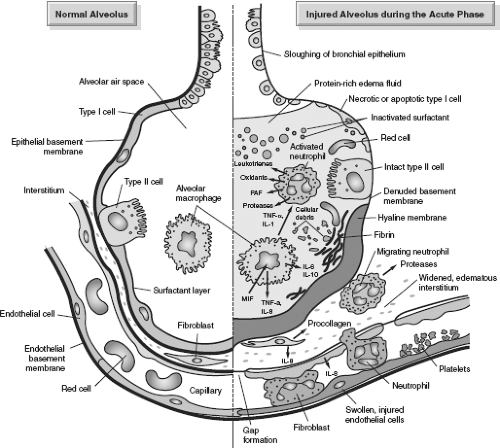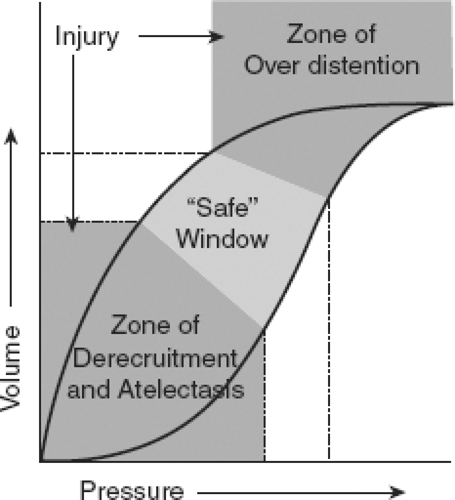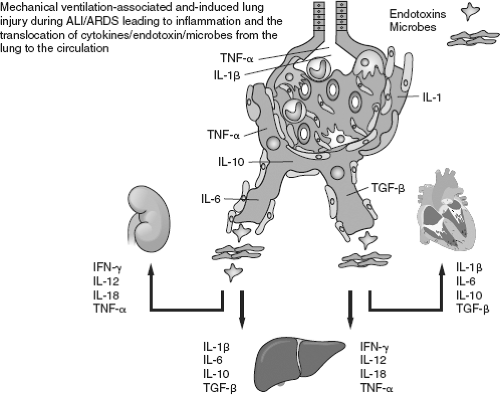Acute Respiratory Failure and Mechanical Ventilation
Cory J. Vatsass
Lena M. Napolitano
I. Introduction
Acute respiratory failure (ARF) is gas exchange dysfunction including oxygenation and/or carbon dioxide elimination. Common etiologies in trauma and acute care surgery patients include pulmonary contusion, pneumonia, atelectasis, aspiration, pulmonary edema, acute lung injury (ALI) and acute respiratory distress syndrome (ARDS), and pulmonary embolus (Table 38-1). Mechanical ventilation and noninvasive ventilation (NIV) are the primary therapies for treatment of ARF.
II. Classification and Epidemiology
ARF is classified as either hypoxemic or hypercapnic. Severe hypoxemic ARF raises the concern for ALI or ARDS.
Hypoxemic respiratory failure (Type I), defined as arterial partial pressure of oxygen (PaO2) <60 mm Hg on room air, is the most common form of respiratory failure and a threat to organ function.
Hypercapnic respiratory failure (Type II), defined as arterial partial pressure of carbon dioxide (PaCO2) of >50 mm Hg on room air.
ALI and ARDS (Definitions in Table 38-2) are syndromes of acute hypoxemic respiratory failure that arise from direct (pulmonary) or indirect (extrapulmonary) insults (Table 38-3) that induce pulmonary inflammation, damage the cells of the alveolar-capillary membrane, and lead to severe ARF. A new definition for ARDS (Berlin definition, Table 38-4) classifies ARDS into mild, moderate, and severe categories, and includes specific amounts of positive end-expiratory pressure (PEEP) at which the PaO2/FiO2 ratio is calculated.
ALI has an estimated crude incidence of 78.9 per 100,000 person-years, with a potential national annual incidence of 190,600 cases resulting in 74,000 deaths. The inhospital mortality rate is 38.5%; the mortality rate increases with age. The rate of ARDS in trauma is decreased with the use of protective ventilator strategies. ARDS and ALI both have pathologic changes and diffuse alveolar damage (DAD) that includes alveolar flooding, characteristic hyaline membranes; this creates the impaired gas exchange and barrier functions of the endothelial and epithelial layers of the alveolar-capillary membrane (Fig. 38-1). Parenchymal injury is not a “diffuse” process, rather has regionalization of the inflammation, injury, and subsequent mechanical abnormalities. This heterogeneity can impact the mechanical ventilation strategy since there is preferential delivery of ventilatory breaths to pulmonary regions with higher compliance and lower resistance (i.e., the more normal regions) rather than to diseased parenchyma resulting in potential regional over distention and ventilation/perfusion mismatch. ARDS stages include exudative, proliferative, and fibrotic phases.
III. Treatment—Noninvasive Ventilation (NIV)
NIV provides positive pressure ventilator support without the need for an invasive (tracheal placed) airway. NIV is a first-line therapy in ARF due to chronic obstructive pulmonary disease (COPD) exacerbation and can decrease mortality, need for intubation, complications, and length of hospital stay. Similarly, NIV is an effective and safe treatment of adult patients with ARF due to acute cardiogenic pulmonary edema.
Table 38-1 Common Etiologies of Acute Respiratory Failure and Need for Mechanical Ventilation
- Apnea or respiratory arrest
- Tachypnea (respiratory rate >30 breaths/min) or bradypnea
- Vital capacity <15 mL/kg, <1.0 L or <30% predicted
- Minute ventilation >10 L/min
- Hypoxemia
- Hypercarbia
- Exacerbation chronic obstructive pulmonary disease
- Respiratory muscle fatigue
- Neuromuscular diseases
- Obtundation or coma
- ALI
- ARDS
Table 38-2 The American–European Consensus Conference (AECC) Definition of ALI and ARDS Developed in 1994
ALI criteria
Timing: Acute onset
Oxygenation: PaO2/FiO2 ≤300 mm Hg (regardless of PEEP level)
Chest radiograph: Bilateral infiltrates seen on frontal chest radiograph
Pulmonary artery wedge: ≤18 mm Hg when measured or no clinical evidence of left atrial hypertension
ARDS criteria
Same as ALI except:
Oxygenation: PaO2/FiO2 ≤200 mm Hg (regardless of PEEP level)
Table 38-3 Clinical Disorders Associated with the Development of ALI/ARDS
Clinical Disorders Associated with the Development of ALI/ARDS
DIRECT insult
INDIRECT insult
PULMONARY
EXTRA-PULMONARY
Common
- Aspiration pneumonia
- Pneumonia
- Inhalation injury
- Pulmonary contusions
- Fat emboli
- Near drowning
- Reperfusion injury
Common
- Sepsis
- Severe trauma
- Shock
- Acute pancreatitis
- Cardiopulmonary bypass
- Transfusion-related TRALI
- Disseminated intravascular coagulation
- Burns
- Head injury
- Drug overdose
Atabai K, Matttiay MA. Thorax. 2000.
Frutos-Vivar F, et al. Curr Opin Crit Care. 2004.
Table 38-4 New Proposed ARDS Definition – “Berlin” Definition
Mild
Moderate
Severe
Timing
Acute onset within 1 wk of a known clinical risk factor or new/worsening respiratory symptoms
Hypoxemia
PaO2/FiO2 201–300 with PEEP/CPAP ≥5
PaO2/FiO2 101–200 with PEEP ≥5
PaO2/FiO2 ≤100 with PEEP ≥5
Origin of edema
Respiratory failure not fully explained by cardiac failure or fluid overloadb
Radiologic abnormalities
Bilateral opacitiesa
Bilateral opacitiesa
Opacities involving 3 + quadrantsa
aNot fully explained by effusions, nodules, masses, or lobar/lung; use training set of CXRs.
bNeed objective assessment if no risk factor present (see table).
The ARDS Definition Task Force. JAMA 2012;307(23):2526.
- Apnea or respiratory arrest
NIV as a weaning strategy for intubated patients with ARF uses early extubation with immediate application of NIV. A recent systematic review notes NIV decreased mortality, ventilator-associated pneumonia (VAP), and ICU and hospital length of stay, and total duration of mechanical ventilation.

Figure 38-1. Pathophysiology of the ARDS. Adapted from: Ware LB, Matthay MA. N Engl J Med 2000;342(18):1334.
The role of NIV in the treatment of ARF for severe asthma exacerbations is less clear, where it must be used with caution and carefully monitored.
NIV can also be used to treat ARF from other conditions such as severe pneumonia, obesity hypoventilation and to improve respiratory outcome in post-surgical patients.
IV. TREATMENT—INTUBATION (see Chapter 3)
If NIV fails or is not possible/indicated, endotracheal intubation is required, with the orotracheal route preferred. The optimal intubating conditions require a combination of short- and rapid-acting sedatives with a neuromuscular blocking agent, often etomidate and succinylcholine. The approach is discussed in detail elsewhere.
After insertion and clinical confirmation with auscultation and capnography, obtain a chest radiograph to confirm position; the target tip placement of the tube above the carina and below the glottis is followed by securing a standard tube at 23 cm in men and 21 cm in women, measured at the incisors. Assure the cuff pressure is adequate and not overinflated. Sedation is required for endotracheal tube and MV tolerance, and intravenous infusions of short-acting opioids and sedatives are used commonly. If volume and hemodynamic status is normalized, a continuous propofol infusion can be used and allows both sedation and rapid recovery with cessation. A sedation scale will aid finding best response to dose of any regimen.
Benzodiazepines may increase delirium, especially in the elderly and in those with organ dysfunction or failure.
V. Treatment—Vap Prevention
Implement aggressive actions to prevent VAP immediately after intubation and initiation of mechanical ventilation. The key components of the ventilator bundle for VAP prevention are as follows:
Elevation of the head of the bed (at least 30 degrees)
Daily “sedation vacations” and assessment of readiness to extubate
Daily oral care with chlorhexidine
Peptic ulcer disease prophylaxis
Deep venous thrombosis prophylaxis
Other evidence-based strategies for prevention can be considered in ICUs with a high prevalence of VAP, including continuous aspiration of subglottic secretions (CASS) tubes, silver-coated endotracheal tubes, and selective oral decontamination (SOD) or digestive tract decontamination (SDD).
Treatment—Mechanical Ventilation (MV)
The goals are adequate oxygenation and alveolar ventilation, reduced work of breathing and minimizing ventilator-induced lung injury (VILI).
The treatment for hypoxemic ARF (Type I) is to improve oxygenation and reverse/prevent tissue hypoxia by achieving adequate oxygen delivery to tissues; seek arterial oxygen saturation >90% on the lowest FiO2 concentration possible. The treatment of failure to ventilate, that is, hypercapnic ARF (Type II), is to increase alveolar ventilation by achieving adequate minute ventilation.
MV can lead to additional lung injury, that is, VILI. VILI mechanisms include barotrauma, diffuse alveolar injury resulting from overdistension (volutrauma), injury caused by repeated cycles of recruitment/de-recruitment (atelectrauma) (Fig. 38-2) and the most subtle form of injury related to the release of local mediators in the lung (biotrauma) (Fig. 38-3).
Variables that can be adjusted for MV include:
Mode of ventilation
Tidal volume (Vt)
Respiratory rate (RR)
Supplemental oxygen (FiO2)
Inspiration/expiration ratio (I:E)
Inspiratory flow rate
PEEP
Trigger sensitivity (effort required to trigger the ventilator to deliver a breath)
Rise time (determines speed of rise of flow or pressure in each breath)
Temperature and humidity of inspired air
Oxygen uptake via the lungs depends on both PaO2 (FiO2, alveolar pressure) and ventilation–perfusion matching (reversing atelectasis, reduce intrapulmonary shunting). To improve oxygenation, use these strategies:
Increase FiO2. Be wary since prolonged, high levels (FiO2 >50%) are associated with oxygen toxicity and absorptive atelectasis.
Full access? Get Clinical Tree









